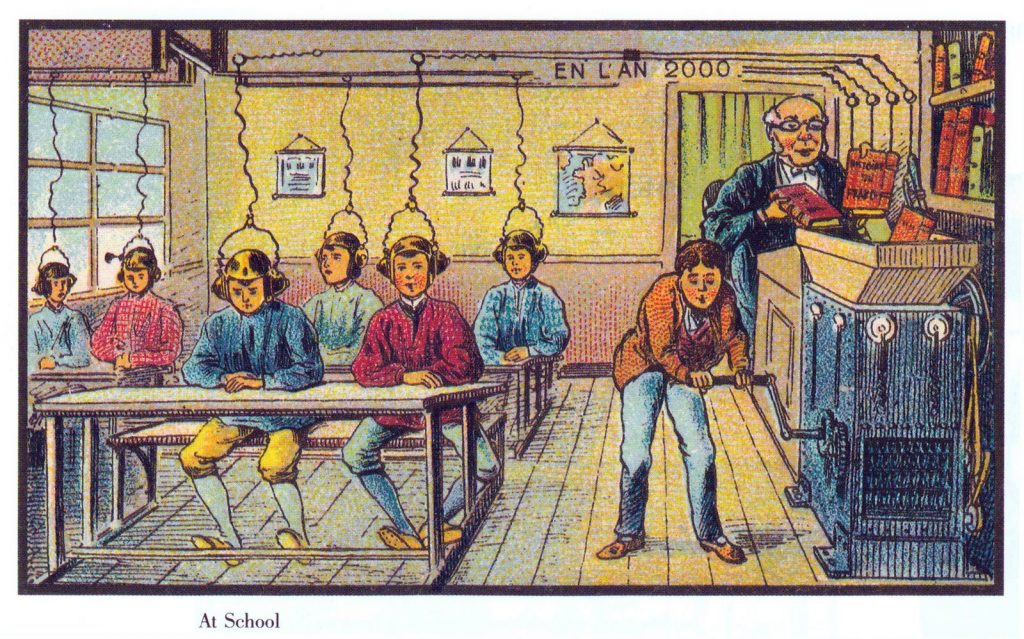Post-Digital Print
“Paperless Office” — ever since it was brought up in an article in Business Week (June 1975), it was probably never this close to its fulfilment in the past few months, not exactly because the digital technologies are eventually ready in all aspects to take over paper-based media, but because the global pandemic crisis has simply made office buildings inaccessible. Still, one sees discussions that regard COVID-19 as a pivotal chance for “going paperless” and online here and there (and here).
Alessandro Ludovico, in his book, Post-Digital Print: The Mutation of Publishing Since 1894 (Onomatopee, 2012), also addresses the idea of “death of paper.” He pinpoints several historical moments when new media and technologies developed, and paper was pronounced dead. In most cases, such prognostications remained no more than wishful imaginations. (Fig. 1) Instead of replacing print, as Ludovico demonstrates, “electricity, radio, TV, computers and the World Wide Web have all affected, transformed and revolutionised the printed medium…” (29) The latter survived, adapted, and developed in tandem with the emerging new media, — a process that Ludovico calls, the “mutation” of print.

So, what is so special about print? And the digital? Ludovico observes some distinct characteristics of the two, and stresses that in the past decades, one sees in the publishing industry always a struggle between the “two opposite (even contradictory) needs,” one for the flexible, the updatable, and the other the physically present, the stable. (8)
- Print: interfacing, usability, reliability, physicality, tactility, (the smell!);
- Digital: content, quantity, updateability, searchability, hypertext, networking capacities. [1]
For print, unlike CDs or vinyl records for music, “the medium… is also the display itself. Changing it consequently changes people’s experience, with all the (physical) habits, rituals and cultural conventions involved.” (153) On the one hand, “the very best ‘interface’ ever designed” (7) of paper-based medium was adopted and adapted into the designs of website and e-book interfaces. Late 2000s even sees a trendy return of the classic paperback format, most manifest in the inbuilt “Download as PDF” function of many websites. (93–4)
On the other hand, print never hesitated to enjoy the benefits the advancing digital technologies had to offer. By mid-1980s, computational and digital supports have been involved in almost every part of typographic production. (80–82) Magazines were eager to include computer-generated contents to enrich the reading experiences with “bonus” on all kinds of new media like floppy disks, CDs, and even 3D glasses, (48)
Instead of “death,” paper medium switched its niches in publishing since its “symbiosis” with the digital. While newspapers were all forced to switch to “digital-only business” in 2000s, (55), “print on demand,” alternative publication, and self-publication have been on the rise (check out the Espresso Book Machine). (71–72) Indeed, as online format is more suitable for something that demands quick updates and relevance like news (as is captured by Falling Times, 2007), (62–6) it is the physical presence of paper, the stability of printed contents, and the social and cultural values thereof that have been conspicuously emphasised in a rapidly digitising age.
“There is no one-way street from analogue to digital; rather, there are transitions between the two, in both directions.” (153) Ludovico aims to present a historicised prospective that transcends the teleological view of technology and shows that despite the competitive nature between paper and pixel, they are in the end, and in practice, complementary. (117) The phrase “post-digital” suggests, as Florian Cramer explains in the “Afterword,” that in an age when the digital is so prevalent, an insistence on a clear cut between the two seems all but obsolete. (162) [2]
Intermingles between the new and old media are nothing new in history. Back in early modern Japan, for example, instead of the movable type that was introduced and only experimented briefly in the late fifteenth century, woodblock prints flourished in the seventeenth century for its capacity to closely reproduce the manuscript, instead of replacing it. (Fig. 2) The block printing technology “made the handwritten available in multiple,” “more vital and visible” (Chance & David, 92–4). [3]

Ludovico states that the significance of the “alternative publication” is “to challenge the prevailing medium, to formulate a new original aesthetic based on the new medium’s qualities, and to generate content which is relevant to the contemporary situation.” (50) Similarly, the many media and technologies employed in the digital image above (Fig. 2) have all too served very specific and practical situations that demanded their unique characteristics.
During the lockdown, while all the paperwork inside an office goes online, the warning signs on the entrance to the office building has to be printed on paper. As we are exhaustively exploring the potentials of online learning (and online teaching), it is also the time when we come to realise how and what kind of the “analogue” teaching practices turn out to be obsolete, “digitisable” or indispensable. If the catchy phrasing of “post-digital print” is also meant to put emphasis on the fact that print after its entanglement with the digital can never escape the “symbiosis,” and its “mutation” is still under way, could we probably say that many aspects of our life in a “post-Corona” world will as well be, more prominently, “post-digital?”
References
[1] There are also examples and artistic attempts to cross over the divide. They nonetheless highlight that the uniqueness of these qualities lies in the fact that it is much more difficult, if not possible, to achieve the same effects and in same capacity in the other medium. A touchscreen is also tactile, for instance, but it cannot be folded or torn apart like paper. For hyperlinks on paper, consider QR-code or Maria Fischer’s Traumgedenken (2010, in Ludovico, 94).
[2] For follow-ups on “post-digital,” see here, or David M. Berry, “Introduction” in Digital Humanities: Knowledge and Critique in a Digital Age, ed. David M. Berry and Anders Fagerjord (Polity, 2017).
[3] Linda H. Chance and Julie Nelson Davis, “The Handwritten and the Printed: Issues of Format and Medium in Japanese Premodern Books,” Manuscript Studies 1, no. 1 (2016): 92–4.
Schreibe einen Kommentar